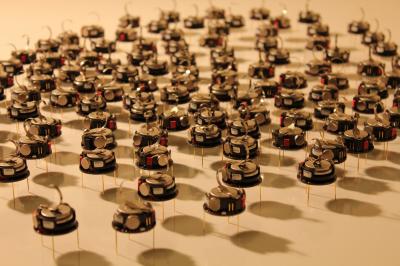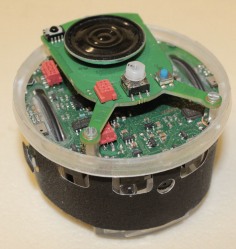Brainless tiny robots form swarms to do work, like bees
April 21, 2014

The 40 e-puck robots used in the research (credit: University of Sheffield)
University of Sheffield engineers have developed a way to make thousands of extremely simple tiny robots cluster to carry out tasks without using any memory or processing power.
The “e-puck” robots form a dense cluster without the need for complex computation, similar to how a swarm of bees or a flock of birds is able to carry out tasks collectively.
The work, published in the International Journal of Robotics Research (open access), paves the way for robot “swarms” to be used in, for example, farms.
So far, they’ve programmed a group of 40 robots to perform the clustering task, but using computer simulations, the researchers have shown that this could be expanded to include thousands of robots.
Each robot uses just one sensor that tells them whether or not they can “see” another robot in front of them. Based on that, they will either rotate on the spot, or move around in a circle until they can see one. In this way, they are able to gradually form and maintain a cluster formation.

An e-puck robot (7.4 cm in diameter and 5.5 cm high) (credit: Melvin Gauci et al./The International Journal of Robotics Research)
The system’s ingenuity lies in its simplicity. The robots have no memory, do not need to perform any calculations, and require only very little information about the environment.
Until now robotic swarms have required complex programming, which means it would be extremely difficult to miniaturize the individual robots.
With the programming developed by the Sheffield team, however, it could be possible to develop extremely small — even nanoscale — machines.
The Sheffield system also shows that even if the information perceived by the robots gets partially corrupted, the majority of them will still be able to work together to complete the task.
“This means we are able to ‘scale up’ these swarms, to use thousands of robots that could then be programmed to perform tasks,” said researcher Roderich Gross. He suggested real world scenarios such as monitoring the levels of pollution in the environment and tasks in areas where it would be hazardous for humans to go.
“Because they are so simple, we could also imagine these robots being used at the micron-scale, for example in healthcare technologies, where they could travel through the human vascular network to offer diagnosis or treatment in a non-invasive way.”
The researchers are now focusing on programming the robots to accomplish simple tasks by interacting with other objects, for example by moving them around or by sorting them into groups.
Abstract of The International Journal of Robotics Research paper
This paper presents a solution to the problem of self-organized aggregation of embodied robots that requires no arithmetic computation. The robots have no memory and are equipped with one binary sensor, which informs them whether or not there is another robot in their line of sight. It is proven that the sensor needs to have a sufficiently long range; otherwise aggregation cannot be guaranteed, irrespective of the controller used. The optimal controller is found by performing a grid search over the space of all possible controllers. With this controller, robots rotate on the spot when they perceive another robot, and move backwards along a circular trajectory otherwise. This controller is proven to always aggregate two simultaneously moving robots in finite time, an upper bound for which is provided. Simulations show that the controller also aggregates at least 1000 robots into a single cluster consistently. Moreover, in 30 experiments with 40 physical e-puck robots, 98.6% of the robots aggregated into one cluster. The results obtained have profound implications for the implementation of multi-robot systems at scales where conventional approaches to sensing and information processing are no longer applicable.
